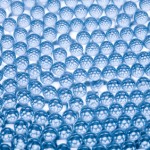 Scientists from the Sweden’s Gothenburg University have shown the possibility to sort and count particles or aggregates formed by particles.
Scientists from the Sweden’s Gothenburg University have shown the possibility to sort and count particles or aggregates formed by particles.
As already know naonparticles of substances can be counted and the size distribution can be determined by dispersing them into a gas. Sometimes nanoparticles tend to aggregate when conditions are changing.
Nanoparticles are parts of particles with diameter smaller than one millionth of a meter. They are not influenced by gravity and don’t fall to the bottom of a gas or liquid. Their contact area with the surrounding medium is very large due to their small size so many properties could arise. Nanoparticles of a substance behave differently than large particles of the same substance. So, certain types of nanoparticles can start to aggregate in different conditions and sometimes a kind of gel may form. Is like the process when an egg is boiled, the proteins in egg white aggregate and form the solid like structure recognized as boiled egg.
As researcher Ann-Cathrin Johnsson from the Department of Chemistry at the University of Gothenburg underlined: “Nanoparticles are already used in many everyday products, such as sunscreen and cosmetics. It is important to be able to determine their size, shape and surface area, in order to be able to improve their properties within various areas of application.”
Ann-Cathrin Johnsson has its work thesis entitled “On the Electrolyte Induced Aggregation of Concentrated Silica Dispersions – An Experimental Investigation Using the Electrospray Technique” which is a study of these aggregating systems, colloidal silica. The gel that forms when salt is added to colloidal silica can be used, for example, to seal rock and to stabilize soil.
As she said: “I started with a method that had been used only for analyzing nanoparticles that had not aggregated, and developed it further. Nanoparticles that have aggregated can be analyzed individually if a colloidal silica gel, which contains these aggregated nanoparticles, is first diluted and then dispersed into the gas phase. If the samples are analyzed immediately after being diluted, this method gives an accurate picture of the gelated system”.



